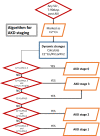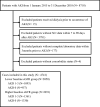Severe acute kidney disease is associated with worse kidney outcome among acute kidney injury patients
- PMID: 35444219
- PMCID: PMC9021248
- DOI: 10.1038/s41598-022-09599-7
Severe acute kidney disease is associated with worse kidney outcome among acute kidney injury patients
Abstract
Acute kidney disease (AKD) comprises acute kidney injury (AKI). However, whether the AKD staging system has prognostic values among AKI patients with different baseline estimated glomerular filtration (eGFR) remains a controversial issue. Algorithm-based approach was applied to identify AKI occurrence and to define different AKD stages. Risk ratio for major adverse kidney events (MAKE), including (1) eGFR decline > 35% from baseline, (2) initiation of dialysis, (3) in-hospital mortality of different AKD subgroups were identified by multivariable logistic regression. Among the 4741 AKI patients identified from January 2015 to December 2018, AKD stages 1-3 after AKI was common (53% in the lower baseline eGFR group and 51% in the higher baseline eGFR group). In the logistic regression model adjusted for demographics and comorbidities at 1-year follow-up, AKD stages 1/2/3 (AKD stage 0 as reference group) were associated with higher risks of MAKE (AKD stage: odds ratio, 95% confidence interval [95% CI], AKD 1: 1.85, 1.56-2.19; AKD 2: 3.43, 2.85-4.12; AKD 3: 10.41, 8.68-12.49). Regardless of baseline eGFR, staging criteria for AKD identified AKI patients who were at higher risk of kidney function decline, dialysis and mortality. Post-AKI AKD patients with severer stage need intensified care and timely intervention.
© 2022. The Author(s).
Conflict of interest statement
The authors declare no competing interests.
Figures




References
Publication types
MeSH terms
LinkOut - more resources
Full Text Sources
Medical
Research Materials
Miscellaneous

